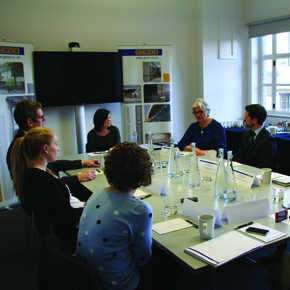
Shutting the door on energy loss and air pollution
Energy usage is coming under increased scrutiny, with news from the National Grid warning of an eleven week energy shortage by winter 2016 and the Hinkley Point C nuclear power station looking unlikely to ever go into commission.
There is never a good time to be wasting energy but now, more than ever, retail businesses need to be doing all they can to both conserve energy and protect employees and customers.
ABC+D’s Claire Mackle recently met with door and window controls manufacturer, GEZE UK, sponsor of the Close the Door campaign, and a selection of industry professionals to discuss the energy saving benefits of supporting the campaign and how, by using closed and automatic doors, air pollution can also be minimised in the internal environment…
Close the Door
Close the Door is a business-friendly initiative working with retailers and restaurants to save significant amounts of energy and greatly reduce exposure to hazardous components of air pollution inside, by closing the door when heating/air conditioning are being used or when there are high levels of air pollution on the street outside.
Independent research data is from Cambridge University engineering department on store doors and energy, and Imperial College/Kings College London on in-store air quality.
Findings were a total energy saving of up to 50% for a small-to-medium sized high street shop, and a one third drop in three of the most hazardous components of air pollution ( NOx, black carbon and PM2.5 ) when the door was closed in trading hours. Original research can be found at www.closethedoor.org.uk
Close the Door was founded in Cambridge and currently has over 500 shops there, and thousands more across the country, of all types and sizes backing the campaign.
Choice of entrance solution
Q: What are the main considerations when specifying doors for retail outlets?
PG: M&S have a variety of different types of doors across our estate. If the doors are made of glass we make sure the glass is insulated. Another consideration is the maintenance cost attached to the type of doors we’re using. My energy department works with the engineering team on the design and specification and we then educate individual stores on how to operate them. At our Stratford Westfield branch we installed a double set of entrance doors to form a foyer as the air outside was creating a wind tunnel into the store.
PB: In terms of acquiring existing assets, the choice of door will be affected by what is originally in place and also, from an aesthetic point of view, whether it works within the context of the surrounding area and creates the right look and feel. An entrance has to portray a welcoming environment, so that will factor into the design. Certainly the practicalities are a key driver.
EB: I think the reason people go into retail stores is for the experience. In terms of the entrance we want to make it as welcoming as possible. We don’t want to create obstacles. An open door would have serious consequences on the internal experience in terms of comfort, temperature fluctuation, interior air quality and draughts. I think we should look at how we can use architecture to create a beautiful experience for both customers and staff. My perspective is very focused on health and wellbeing, active design, the use of colours, the look and feel and also thermal and visual comfort.
KS: Elisa has captured the essence really. As a manufacturer we have a number of reference sites that will be either historic buildings or very modern projects. Requirements often differ in terms of aesthetics, environmental goals and energy concerns. Each of our customers have some or all of those demands. It is these projects that we probably enjoy the most. We much prefer to work with a customer that is switched on with an environmental or aesthetic challenge because that’s where, hopefully, we create the most value.
Q: Do you have automatic doors in all of your stores?
PG: You have to operate within the requirements of the Disability Discrimination Act and the Equality Act 2010. If you don’t use automatic doors then you should specify push button access solutions. We also use revolving doors. Similar to John Lewis, our estate consists of historic grade listed buildings through to modern, new developments, meaning the spec can differ wildly.
PB: We certainly will be compliant with the minimum legal requirements and we also have dedicated professionals examining customer journeys and designers looking at the practicality and functionality, followed by engineers and energy managers looking at running costs. As with any large retail business, energy is a huge aspect and the risk, particularly around security of supply is a huge issue so, yes, we have lots of people looking into how we can be as efficient as possible in our operations so this is a topic that people will be well versed in.
Q: What are the reasons for not using automatic doors?
PB: As Penelope said, there may be some historic buildings that have architecturally interesting doors and lobbies where you can’t install automatic doors. I can think of one or two with rotating doors.
There may be scenarios where a store is a tenant in a bigger scheme which is close to the entrance but they don’t have any direct control over that space. However, when we are occupying this type of scheme we have a very close relationship with the developer and ensure they are aware of our baseline specifications so that we get across what we are looking for.
Design
Q: How important is it to consider sustainability during the design or retrofit stage?
PG: If you don’t consider something at the design stage, the cost of making changes is 80-100% more expensive. So it’s always important to get it right at the design stage so that you don’t end up paying to make corrections.
Q: What other options or solutions are available if automatic doors are not appropriate?
PG: Our Simply Food stores specification is to always use automatic doors as far as I know. However, we evaluate every store individually due to planning regulation.
KSum: Certainly for some of the smaller stores, there are manual control and self-closing solutions that can allow doors to close. In a lot of older buildings these can be retrofitted. Automatic doors are a great solution but if they are not an option then manual control systems are also a good solution. They are aesthetic, they can be under floor, they can be built into the door design itself and different colour options are also available. They can also be sustainable without affecting overall design.
KS: Regarding accessibility, there are manual door controls available which are preset for regulations for access by the disabled. However, a better solution is automatic doors. The whole subject of accessibility is at the forefront of everybody’s minds so, really, it’s back to this designing-in when you can because it’s going to be a lot cheaper and easier to integrate if you do that.
Perceptions of an open door policy
Q: What are the challenges to adoption of the Close the Door campaign across all stores?
PB: We’re a signatory to the campaign but not withstanding that, there’s a challenge to any sort of movement and it will be making sure everyone is aware of the benefits offered, de-risking it and convincing people that it’s not going to cost more or that it’s not going to restrict access.
It may be that there is an opinion from certain individuals that closing a door might restrict footfall. I think, generally, we’re pretty good at closing the door. We recognise the benefits of doing it so, thankfully, I’m not having to work too hard to convince people. But I do think that if I asked someone on a different team whether they were aware of the impact, they probably wouldn’t understand the significance of some of the statistics, so it’s a case of changing perception to fully recognise how important it is.
PG: M&S are also a signatory to the campaign. We try to educate our store colleagues as much as possible. Some people still think that if a customer sees a door closed, they’re not going to come in. I don’t think there’s enough publicly available research or statistics demonstrating that it doesn’t affect footfall.
JD: I think leaving the door open is going to become very unpopular very soon because the air pollution stats are really recent and people on the whole don’t know about them. (The current death toll statistics from air pollution in London are 10,000 a year and 30,000 across the UK as a whole). I can tell you that the mums groups that do know about the air pollution stats don’t want to shop in stores that don’t close their doors.
CM: So it’s an education project really isn’t it?
JD: It’s a huge education project. A lot of the retailers I’ve come across, and there are lots who say footfall will suffer, tend to be slightly old fashioned, especially when it comes to sales. The door issue is highlighted much more when people can see that energy is being wasted during the winter months. In the summer, particularly without air con, the air pollution problem is invisible and it’s important to educate people to realise that it’s just as important for them then that the doors are closed.
Q: Is it customer driven? Do customers prefer open doors?
JD: I know a lot of people don’t prefer open doors, including disabled groups.
PG: There doesn’t appear to be sufficient research around this topic publicly available, to actively promote what the customer thinks. My team’s objective is to save energy, reduce cost and consider the environment, as well as promote collaboration with colleagues to work in the best interest of our customers and employees.
JD: There are lots of companies that close the door across the board and they have all done their own research. They wouldn’t be closing their doors if it wasn a problem for profit. So, the research is there but, unfortunately, retailers don’t want to share it due to it being competitive information.
PB: I think customers, especially of larger retail units, are probably just used to the fact that that’s how we do it. There is perhaps a difference with testing it in, say, hospitality and restaurant environments. If you went to a retail park and you tested three of them there with the doors closed and one with the door open and they’re all similar style restaurants, did everyone go into the one with the door open? I don’t think that’s the case.
JD: Costa has closed the door across its estate and it’s very clear that in the hospitality industry they have a huge interest in keeping the door closed. Kids don’t run out; you’re much more comfortable. It’s been done and demonstrated.
PB: I haven’t heard grumblings that it’s a huge customer driven issue.
PG: I would say that both customers and employees prefer a comfortable store environment.
JD: The Cambridge study has proven that a closed door provides a uniform heat across the store, so that you’re not boiling in one area and draughty in another. Also, that you cannot provide CIBSE guidelines for a healthy working temperature if you don’t close the door with the heating on. If the door is open then the temperature variation will be far too extreme.
LT: Jeannie, do you find that you experience more problems with smaller retailers keeping their doors closed?
JD: The independents are generally very good because they pay their own energy bills.
Q: How can you balance aesthetics with curb appeal? Can you combine the welcome factor with sustainability?
EB: From an architectural perspective, visual appeal, aesthetics and the use of colour can all contribute to the welcome factor, but we also need to consider the quality of the retail environment itself. I think it is important to think about the customers and what they really value and care about, and personally, I am not convinced their priority is whether they need to open a door or not to enter a retail space.
In terms of sustainability, I think we should communicate to the customer what a closed door means for their health as opposed to an open door. Customers are there for shopping, and I am not sre they are making the link between feeling good in a particular space with the fact that the door is closed or open. We should be more proactive in communicating to them the benefits of shutting out air pollution and avoiding thermal discomfort: closing the door is not only good for energy saving, but also for promoting people’s health and wellbeing. I believe this is a crucial factor in support of the Close the Door campaign.
JD: It is becoming increasingly clear that customers think that entrances are important and if these are left open it makes them very suspicious as to whether the company is actually carrying out what it claims to be doing in CSR generally.
PG: It’s a fine line between balancing greenwashing and aesthetics. Certain shopping centre developments are driven by brand. It’s all about selling luxury and what fits with that, be it marble floors or glass etc. The energy side of it may only become apparent due to a tight planning schedule. Retailers often have to fit in with the development /developer if they want to occupy that particular space.
EB: We are working our clients to create buildings that optimise occupant’s health as well as environmental outcomes, places that both staff and customers can truly enjoy. It is now clear that energy efficiency alone is not sufficient to demonstrate brand excellence, as in most cases it is something that must be done anyway to comply with regulatory standards. With global trends showing an increasing focus on wellbeing, organisations have an imperative to boost the health and wellbeing performance of their building portfolio, and I definitely think this is going to have a powerful impact on both the retail experience and sales performance.
Health and wellbeing
Q: Do you record whether illnesses aggravated by pollution (such as asthma) are causing staff sickness?
PB: I think it’s probably very difficult to track what has caused absenteeism specifically. We’ve spoken a lot today about the customer, yet arguably I would say that the staff have more of a vested interest in this because they are the ones that are going to be exposed to air pollution for far longer periods and are therefore more at risk. We are certainly looking at indoor air quality as being a factor of things like BREEAM and other environmental assessment methods, and Part L and Building Regulations will dictate air change rates and so on. I’m looking into how we weave more granularity into design standards. Health and wellbeing has got a lot of traction and we’ve been monitoring things like productivity versus general happiness. As you know, health and happiness tend to go hand in hand. We know there’s a correlation, we know it makes sense to do it, so the challenge with that is just with quantification. So, going back to your question, we certainly want to track and understand if there are health impacts through air pollution and want to try and prevent it. However, I think it would be difficult to track.
KS: Without data, it’s pretty difficult even for even the Government to communicate what’s going on. I think we should focus on the reverse of this which is best practice. Close the Door proves that a 30% reduction in particulate can be achieved in the internal environment. If you are closing your doors then you are doing the best you can to prevent staff sickness.
JD: The research data is there showing that a lot of these deaths from air pollution are concentrated around working on the road and close to busy roads. A lot of the high street shops are on these roads which presents an accentuated risk.
PB: You can track pollutant concentration on somewhere like Oxford Street and you can map out how that disperses from the centre of the road, but to then track how many staff in those buildings have had some sort of respiratory problem as a result proves difficult. It’s often down to increased mortality, people dying sooner than they should have. It’s very difficult to pin point how this is a direct result of an air polluted bus route for example. It’s a big, big issue definitely.
JD: One of the big problems is that a lot of people working in retail feel they have absolutely no voice; that they may lose their jobs if they ask for better conditions. Shop workers are a very fluid and quite often badly paid group of people. It is important that responsible retailers take the lead.
PG: I know Marks & Spencer records illness across the business. If we had high absenteeism, we would look at what the possible reasons for this were. Similarly, we have a very strong voice like John Lewis Partnership amongst our employees where they would raise the concerns. So I don’t think that they would feel that they would be ostracised for complaining. However, there are also so many other health factors that can contribute to respiratory illnesses. It would be very hard to monitor.
Q: Will today’s discussions affect your thoughts about keeping the door closed and the solutions available?
PG: I don’t think it will change M&S policy. I think it will just reinvigorate the question around education and communication with employees and customers, not just from an energy perspective but also from a health and wellbeing point of view..
PB: Likewise, we are aware of the issue but I am thinking, as a quick exercise, of looking at mapping out some of our stores against some of the areas of higher pollution risk and even thinking about looking at more modern trends. We monitor air change rates and thermal comfort but we don’t necessarily use NOx tubes or anything like that. I know from having spent years monitoring sites that they are pretty easy to install and check, so that would be quite a useful exercise. Particularly at somewhere like Oxford Street.
Q: How are you planning to move the campaign forward Jeannie?
JD: There is work to be done with the Health and Safety Executive as some interesting legislation on preventing businesses unnecessarily exposing the workforce to airbourne pollutants has come to light. A Member of Parliament is putting together a cross-party working group on the aims of the campaign, and it is now clearly vital to inform and involve customers as, to date, it has largely been based around the retailers.
ABC+D welcomes your thoughts below on energy saving, air pollution and the Close the Door campaign.
Latest news

11th April 2025
Don’t Do a Dave! It’s Time to Lock FIT Show 2025 in Your Calendar!
It’s that time again – FIT Show is back! You could be forgiven for thinking there won’t be much new to see when FIT Show returns to the NEC from 29 April – 1 May. Wrong!
Posted in Articles, Building Industry Events, Building Industry News, Building Products & Structures, Building Services, Continuing Professional Development (CPD's), Exhibitions and Conferences, Information Technology, Innovations & New Products, Restoration & Refurbishment, Retrofit & Renovation, Seminars, Training
11th April 2025
Insight Data: Boost construction success with project and prospect data
For those working in construction – in whatever capacity – the last few years haven’t been much fun. And according to the latest statistics, it would seem the challenges are continuing – Alex Tremlett, Insight Data’s Commercial Director, has more…
Posted in Articles, Building Industry News, Building Services, Information Technology, news, Research & Materials Testing
11th April 2025
ASSA ABLOY EMEIA: Learn how to tackle the security challenges of digitalising access with insights from industry experts
In a new series of videos, experts in various specialisms within ASSA ABLOY share their expertise on digital access, including the complexities to overcome and the range of benefits for those who get digital access right…
Posted in Access Control & Door Entry Systems, Architectural Ironmongery, Articles, Building Industry News, Building Products & Structures, Building Services, Doors, Facility Management & Building Services, Information Technology, Innovations & New Products, Posts, Restoration & Refurbishment, Retrofit & Renovation, Security and Fire Protection, Videos
10th April 2025
Geberit completes 150 Acts of Kindness
Geberit has raised nearly £14,000 for various charities through its ‘150 Acts of Kindness’ initiative, a year-long programme of fundraising and volunteering to mark the company’s 150th anniversary in 2024.
Posted in Articles, Bathrooms & Toilets, Bathrooms, Bedrooms & Washrooms, Building Industry Events, Building Industry News, Building Products & Structures, Building Services, Charity work, Drainage, Interiors, Pipes, Pipes & Fittings, Plumbing, Restoration & Refurbishment, Retrofit & Renovation
 Sign up:
Sign up: 



